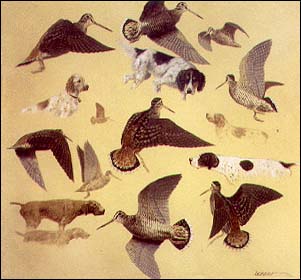Homepage
Contact
HUNTING IN FRANCE
Woodcock
(Bécasse)
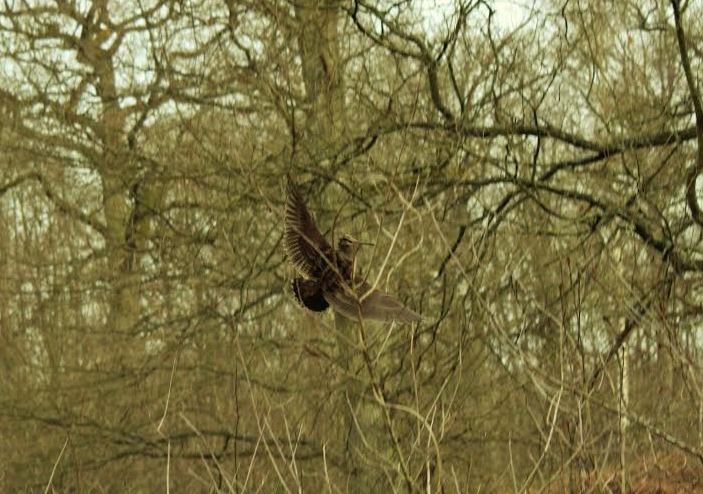
Rare snapshot of a woodcock taking off - by my nephew Melchior, Ste Appoline Feb, 2015
Season
From November to Feb 20th.
Regions
We
mainly hunt in Normandy, but woodcock currently visit or stay
everywhere in France. The Pyrenees, Brittany, Provence, Burgundy and
Bordeaux-Médoc (near the famous vineyards) are reputed regions.
Species
Scolopax rusticola
(bécasse des bois)
Hunting
woodcock in France
Woodcock is hunted over pointing dogs with bells. (No
beeper). Woodcock can be flushed during any upland
day but real woodcock hunters use specialized dogs trained to
hunt mainly or only this wonderful bird.
Bag Limit
& French Woodcock Society (CNB) policy

C.N.B
Bag limit of 3 (sometimes 2) birds per hunter and per day, and 6 for a group. A group starts with 3 persons.
We want things to be clear, we do not claim for any endorsement of the CNB -Club National des Bécassiers- our over 50 years old woodcock society- but we are fully hunting in accordance with its rules and firstly with its motto -Chasser le plus possible en tuant le moins possible- In English, "Hunt as much as one can, kill as few as possible". The birds are only shot on solid points. We will not hunt during severe periods of cold. We will respect the agreed bag limit. Our dogs only carry tinkerbells, never any electronic device.
Websites
C.N.B "Club National des Bécassiers" French Woodcock Socity - The C.C.B "Club de Cazadores de Becadas" Spanish Woodcock Society. The best dog bells in the world, in Nay, Béarn (Pyrenees). From these webpages you will have access to more links and woodcock pages like the excellent website of the Club della Beccaccia in Italy.
A woodcock experience in France...
Normandy
Day trip at 130 km from Paris
Program
The night before the hunt is spent outside Paris in the town of Saint Germain en Laye. Your hotel could be the Pavillon Henri IVth, a beautiful historical building where the king Louis XIVth, Alexandre Dumas and Ernest Hemingway have stayed before you. I will pick you up there in the early morning. We will be hunting a noble oak and beech forest in Normandyfrom 9.00am to 5.00pm. If your wife is traveling with you, she can wake up later, and from the hotel, she will be able to occupy her day in Paris or Versailles or simply stay around. Walking and shopping in the streets of Saint Germain en Laye is very pleasant. There is a street market on Tuesdays and Fridays and an outstanding archaeological museum. The heart touching "Monte-Cristo" house of Alexandre Dumas can be visited within a short taxi ride. On request we can arrange countryside accommodation in a village near the forest, but Saint Germain en Laye is much more convenient. In the late afternoon I will take you back to your hotel. As another alternative, the night after the hunt can be spent in Paris, but again Saint Germain en Laye is probably more convenient and relaxing.
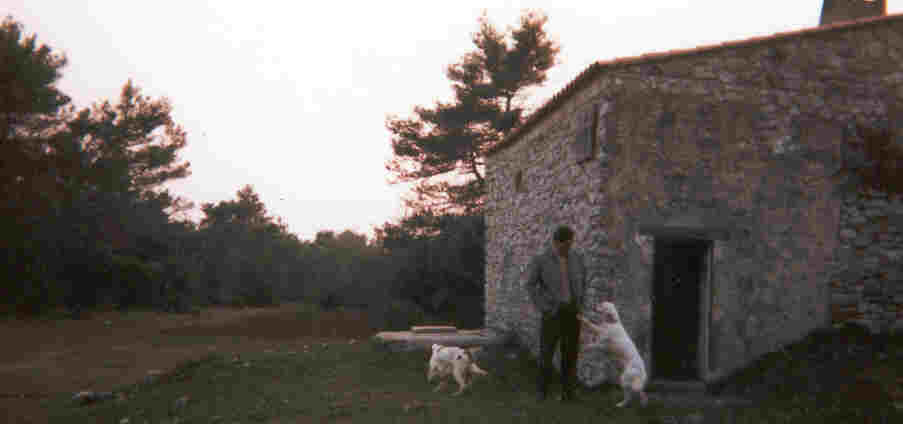
At dawn with a pair of setters in Provence
*
Woodcock over pointing dogs....
French hunters love woodcock over dogs as this bird really reveals the qualities of good dogs. Woodcock is never a game bird of many shots. Sometimes it is really scarce. But the lucky hunter has dogs we say here inventing birds when there is none. Dogs that always find birds, whatever the covert or the size of the woods, no matter who passed before him. This dog will always find and point even the meanest only bird present, and will keep bird and point whatever the time the master needs to find him. Each bird has its own story and I know old woodcock hunters (les vieux bécassiers) in their 80's who are able to tell you all details of almost each bird they shot... or missed ! during a 60 years career. We rigorously apply the famous motto of our Woodcock Society, the CNB: Chasser le plus possible en tuant le moins possible. "HUNT AS MUCH AS YOU CAN BUT SHOOT OR KILL AS LITTLE AS POSSIBLE". The CNB, (Club National des Bécassiers, has a website in French that you can find from this page).
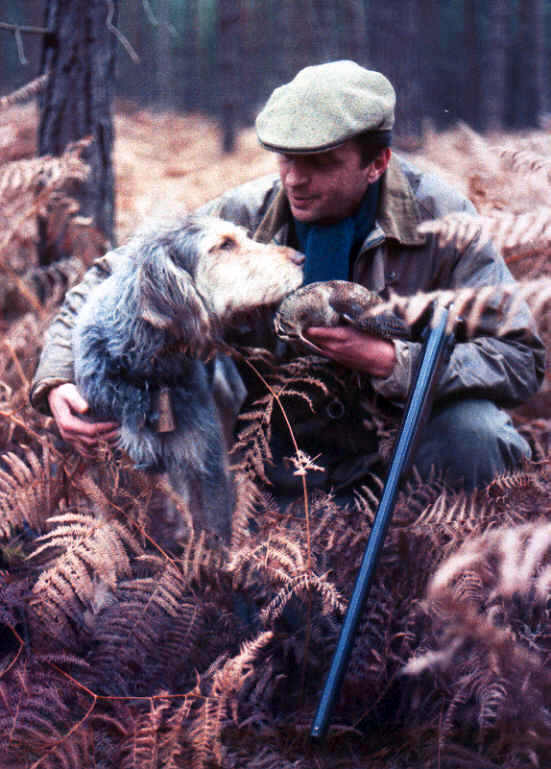
Glorious days with
Jumbo in the Ft of Bord-Louviers
I have been asked sometimes what is the breed of Jumbo ? - Jumbo was what is called in English a "pointing griffon". The usual name in French is Griffon Korthals or simply "Korthals" . More precisely it is a "Griffon d'arrêt à Poils Durs Korthals" or "GAPDK" in the abbreviations used for field trials and technical documents. During the late 19th century, Edward Karel Korthals was a Dutch game keeper serving a German prince who sponsored his work. He created the griffon now known as "Korthals", by mixing and fixing several sorts of old breeds of griffons, hounds and pointers, Italian "spinone" and woolly haired "barbets" waterdogs. The Korthals is a totally different dog from the German wire hair. If you make a google search with the words <<griffon korthals>> or <<club du griffon korthals>> you should find more informations. Picture below: Discovering the mill of Coat-Cren in Brittany
A day's woodcock hunting in France...
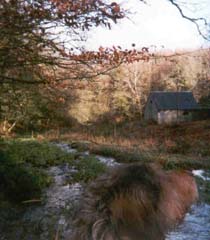 You
are walking silent in a
cold winter morning, in the shade of a big forest. The dogs are so
happy to run
freely that their good mood becomes yours. Your soul is like running
with them, and they really run with pleasure. Most of the time you
can't see them but they're both carrying a nice sounding bell, each
with a different
sound. You walk and often stop to listen at the bell's sound. The frost
cracking under your boots, and the song
of the bell in the valley are really nice sounds. The canter gives the
tempo, but they're meeting some presence...
the bell pounds differently and so does your heart. Suddenly a total
silence fills the wood. Where are
they? (most French hunters refuse to use these horrible beepers), walk
quickly where you last heard them. Now you're close.
It is very bushy here. There is a good smell of young pines and
rosemary bushes. Where are they ? A light whistle between your teeth.
The good old dog shakes his head a little bit and
rings his bell smoothly and then silence again. Now you know where they
are. Just under these young red oaks with a big
holly on the right. Now the shotgun is ready. A few more steps, and you
can see the gray silhouette of one dog in the ferns
under the oaks, and soon the black other dog by the holly. Find out
where the heads are pointing. The last meters are
difficult, you try to step on these brambles instead of forcing them.
Here is not too bad. You are waiting with
the gun ready. It is lasting a bit but you love it. The dogs are on the
scent like a wine connoisseur on
an old château Margaux. Not a shiver, but the grey's head slowly
moves left, and the dog stands up again,
looks at the sky and suddenly the wings clack and the two bells start
again. Mer... ! where is she !!? This
brown arrow in the red oak leaves and... BAW !...??? Yes SIR ! she's
DOWN ! Cap in hand, salute ! Now you're here
standing, admiring this beautiful bird in your hand. The priest never
sees you very much at the church but you
know that only a wonderful God has been able to invent such a beautiful
creature. It is the moment you're a bit
sad. The dogs are up again, for them this moment is already far behind.
This is nature, that's how it is. You start
walking again with a sort of sorrow and your gun is a heavy burden to
carry... But... How are we going to cook that one
? Who will we invite for dinner ? Hé! Hé! you're smiling
again and walking with new joy. HEY YOUU !
DOHOGS ! you're shouting. Wait for meeee ! HO ! HOO !
You
are walking silent in a
cold winter morning, in the shade of a big forest. The dogs are so
happy to run
freely that their good mood becomes yours. Your soul is like running
with them, and they really run with pleasure. Most of the time you
can't see them but they're both carrying a nice sounding bell, each
with a different
sound. You walk and often stop to listen at the bell's sound. The frost
cracking under your boots, and the song
of the bell in the valley are really nice sounds. The canter gives the
tempo, but they're meeting some presence...
the bell pounds differently and so does your heart. Suddenly a total
silence fills the wood. Where are
they? (most French hunters refuse to use these horrible beepers), walk
quickly where you last heard them. Now you're close.
It is very bushy here. There is a good smell of young pines and
rosemary bushes. Where are they ? A light whistle between your teeth.
The good old dog shakes his head a little bit and
rings his bell smoothly and then silence again. Now you know where they
are. Just under these young red oaks with a big
holly on the right. Now the shotgun is ready. A few more steps, and you
can see the gray silhouette of one dog in the ferns
under the oaks, and soon the black other dog by the holly. Find out
where the heads are pointing. The last meters are
difficult, you try to step on these brambles instead of forcing them.
Here is not too bad. You are waiting with
the gun ready. It is lasting a bit but you love it. The dogs are on the
scent like a wine connoisseur on
an old château Margaux. Not a shiver, but the grey's head slowly
moves left, and the dog stands up again,
looks at the sky and suddenly the wings clack and the two bells start
again. Mer... ! where is she !!? This
brown arrow in the red oak leaves and... BAW !...??? Yes SIR ! she's
DOWN ! Cap in hand, salute ! Now you're here
standing, admiring this beautiful bird in your hand. The priest never
sees you very much at the church but you
know that only a wonderful God has been able to invent such a beautiful
creature. It is the moment you're a bit
sad. The dogs are up again, for them this moment is already far behind.
This is nature, that's how it is. You start
walking again with a sort of sorrow and your gun is a heavy burden to
carry... But... How are we going to cook that one
? Who will we invite for dinner ? Hé! Hé! you're smiling
again and walking with new joy. HEY YOUU !
DOHOGS ! you're shouting. Wait for meeee ! HO ! HOO !American hunter (with hat)...
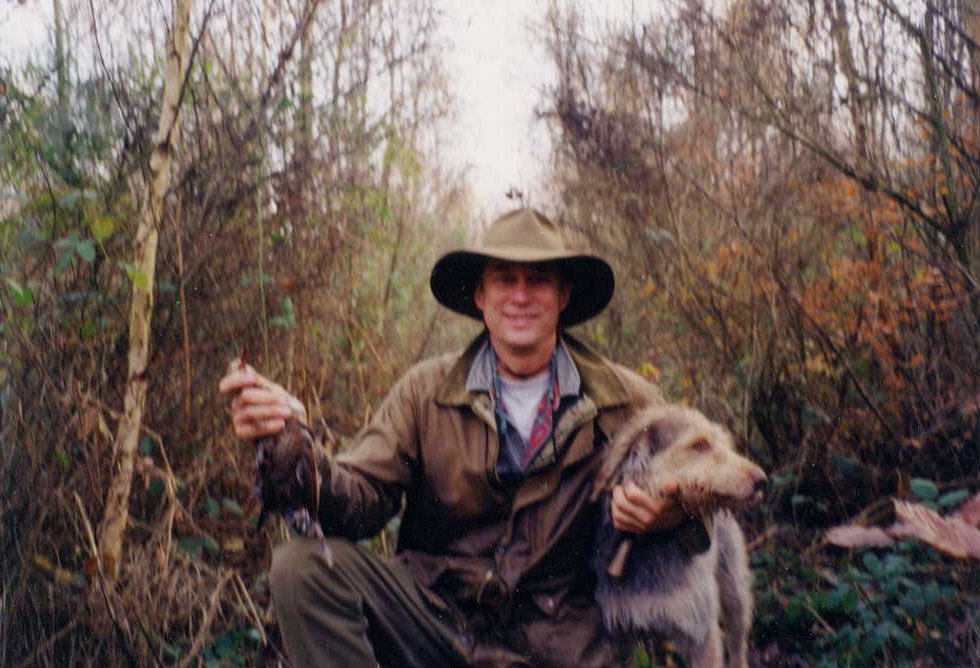
... French griffon (with bell), and European woodcock scolopax rusticola
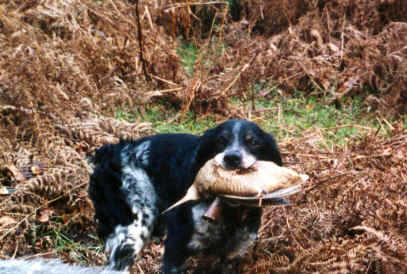
Scolopax rusticola is a bigger bird than Philohela minor
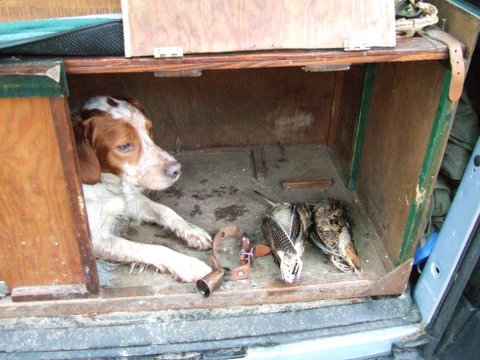
Closing the 2004 2005 season in Normandy
Recipe
The roasted Bécasse "A ma manière !"
Also named "Bécasse aux bowels" by Kirk Hogan
1/ La Bécasse (the woodcock) & 2/ La Rôtie (the toast).
La Bécasse.
Make a delicate incision on belly
and put all the "insides", on a cutting
matt.
Take the bird in your left hand and the head (still attached but eyes
ripped off), in the right hand. Push firmly
the bill through the legs at level of the knees. This way the bird is
presented, "à la mode classique".
Melt some butter in your fingers and proceed a massage of bird's body,
then season the skin with salt and pepper
.
The bird is (or birds are) then placed on a steel dish and put inside
hell fire oven, accompanied by one or two
garlic cloves "en chemise" (keeping the outer skin).
La Rôtie (the toast) (2)
Chopp the "insides" with a good
knife, (get rid of the gizzard, which looks
like a little hard ball). Put everything in a small casserole with a
"nut" of butter, on not too warm
a fire.
You will quickly see a smooth transformation (difficult to explain) of
color and aspect. When it's all "transformed"
like after 3 or 4 minutes, take some wheat flour with your fingers and
pour in rain on this. Mix thoroughly and
wait another minute.
Add a drop of Armagnac, and heat a bit more. Prepare a lighter, when
you see its OK, Fire ! Whaoum !!! flambé
the Armagnac ... take away from fire, mix again thoroughly adding very
little of salt and pepper. Leave it apart,
it should look like a brown paste.
The toast themselves are pieces of
bread that you should have left on air since yesterday.
Fresh bread doesn't work for this.
Heat some oil in a pan and roast (or better said, fry) the bred slices
on both sides. Blond is the colour to obtain
and the surface of the bread must be crusty. French baguette bread is
the best, but white bread US or UK style
should work also. (I guess a good baker's loaf will be better than
industrial plastic bread).
If you take a French baguette as a measure, you should get two toasts
(cut into slices shape) per bird. So if it's
the big square Anglo Saxon bred, one toast cut in two triangles will do.
When these are blond (this operation can be done as # 1st, any time
before), place them on a grill or on absorbing
paper to get rid of some frying fat.
Take your casserole with the insides and Armagnac preparation and
spread over the toasts.
Back to the Bird.
It must be "golden brown", like any roast chicken or
partridge. It must be well cooked everywhere
but absolutely not dry. It's an art ! Also it must have produced a nice
gravy singing (but not burning) in the
steel dish.
Garlic must offer no resistance to a fork. If it is still hard, it
usually means that birds are not cooked enough.
It mostly depends on the number of birds. 8 birds will need more time
than 6, needing also more time than 1 or
2.
Usually with 30 minutes it is all OK.
Now you think your birds are "to the point", turn the oven and follow
me:
1/ Bend birds on the steel dish to get all the gravy that is inside.
2/ Place the birds waiting somewhere where they won't get cold.
3/ Place your toasts inside the still hot oven.
4/ Put your steel dish on a fire. Scratch the bottom with a fork. Mash
with the fork one of the garlic cloves.
Add a drop of the red wine you will drink at the table, plus a very
small wee of Armagnac and a few drops (5 or
6) of lemon juice. Add a little of thyme, correct the salt and pepper,
let it boil once - the result must be brown
- and put in a warm saucepan.
Put one bird on each (hot) plate with the two toasts around but the
gravy apart. Just use the gravy gradually,
toasts are not gravy sponges !
No vegetable is expected at this moment of the meal. A salad as a
follower should be enough for today.
Remember that Armagnac and wine must be used with great discretion and
should not mask in any way the taste of
the gravy or be too present on the toast. (Neither should the lemon,
only the cook must know that this light acid
touch comes from lemon. If someone recognizes lemon... you'll just do
better the next time).
Eat comme des cochons... (like pigs), there must be no leftover
of flesh on any bone.
I finally cant resist paraphrasing Alexandre Dumas at the end
of his recipe for snipe called: "Salmis
des moines Bernardins" in the Almanach des Gourmands of the year
1806
"You must pay great attention to giving forks to the guests in the fear they could devourish their fingers if those had touched the sauce" !
And as we speak of literature, you can also end up with the
tradition of the "Dîner des bécasses
du baron des Ravauds" of Guy de Maupassant in his Contes
de la Bécasse.
Take an empty bottle of good wine, replace the cork on top
and push a pin on top of the cork. Set a woodcock
head on the pin, place it all at the center of the table. Ask an
innocent hand to push the bill and make the head
turn -its a sort of woodcock roulette. When the head stops, the bill
should be pointing one of the guests. This
one has the privilege to eat all the heads but must tell a good long
story to the others while they light a cigar
and sip their Brandy warmed up by flames of the fireplace. (If you want
the story to be good, watch out the number
of bottles you serve, the right point is between generously and too
much).
Amitiés en Saint-Hubert / Nick

(1) La plume du peintre
The painter's feather, is an elegant small sharp feather found at each elbow and there is only one on each wing. It was used by naturalist painters for its sharp precise point. It is the small feather crossing the bell on the CNB's logo, but it is much smaller than the bell. Only like 2 or 3 centimeters long maximum. Some hunters place it inside their hat's belt as a trophy to carry all day. Others keep them in a small box for the sad moment when their good woodcock dog will leave this world. A framed picture is realized with all the pairs of feathers displayed nicely as little trophies recalling each bird pointed and bagged during the career of the good dog.
(2) Note for people who are learning French...
The word "rôtie" sounds more like roasted piece of meat, but the ancient translation for toast was "rôtie". Now we use the English word "toast" for breakfast or tea time but "rôtie" or "croûtons" in this case. However, "rôtie" is more proper. A roast beef would spell "rôti" without "e" at the end.
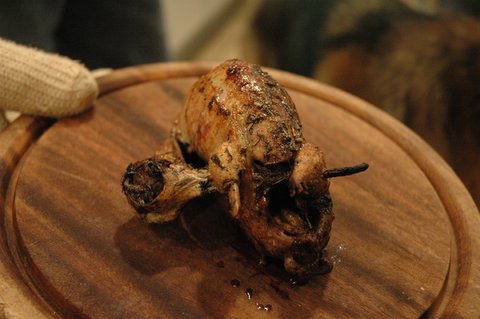
*
In search of
woodcocks, on the "Risoux",
in the Mounts
of Jura near the border with Switzerland.
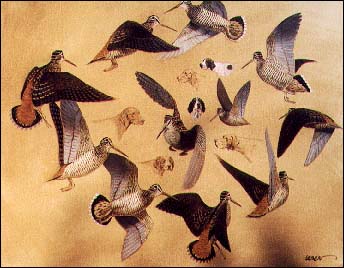
Etude bécasses et chiens d'arrêt -woodcock & pointers - by François Lebert
